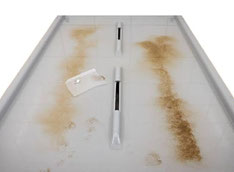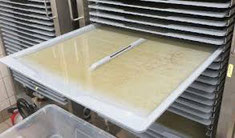Mosquito Larvae Mass Rearing Trays
IAEA Mosquito Rearing Trays

Mosquito Larvae Trays. Standardised larval rearing units for insect production are essential for the establishment of insect mass-rearing facilities. We offer water-filled mosquito rearing trays according to the specifications by the Joint FAO/IAEA Division of Nuclear Techniques in Food and Agriculture (FAO/IAEA-IPCL; Balestrino et al., 2012). The trays are compatible with the Mosquito Mass Rearing Tray & Racks / modules; each holds 30 mosquito rearing trays (50x in the XL version). The mosquito trays are optimized to work with the automatic larvae feeder.

- The mosquito mass-rearing tray is designed to provide a large surface area of shallow water - closely mimicking natural breeding sites and allowing for the larval diet to be easily accessible. Continue reading
-
According to research, the mosquito tray is applicable for rearing larvae of several mosquito species. For Aedes albopictus, for example, the optimal larval rearing density in the water-filled trays is about 18,000 larvae (3.6 larvae cm-2 inner surface). At thirty-four hours after the first pupation, the average male pupae production was found to be ca. 3.16 × 105; no impact on male mating competitiveness to wild type females was found and the tray was recommended to be used in mosquito mass rearing facilities (see Zhang et al., 2017 for details). Regarding Anopheles sp., each trays can hold about 4,000 larvae (Mamai et al., 2018). The use of the trays for rearing other insect species requiring similar environmental conditions for pupation is likely but can also be adjusted on request.
Mosquito Trays - features
- IAEA Insect Laboratory approved design & material
- Space efficient, maximizes rearing area
- Mimics natural Mosquitos rearing conditions
- Overflow system, allows for top filling of all trays per rack
- Co-designed for Mass Rearing Racks
Options:
- Modified dimensions, following user specifications
| Specifications | Mosquito Mass Rearing Trays | OPEN |
|
Mosquito Tray (IR-MMR-Tray) specifications are based on Balestrino et al. (2012) & technical requirements of IAEA/FAO Insect Unit (Seibersdorf, AT).
ABS has been approved by the IAEA insect laboratory as a suitable material for the mosquito trays, while fiberglass and metal trays are not currently considered. |
||
| References | MMR-Trays | OPEN |
|
||
Preparing Mosquito Trays for Larvae Rearing
- To prepare the large trays for mosquito larval rearing, it is recommended that each tray be filled with 5-6 liters of water the day before the L1 larvae are introduced. Water can be added from the top tray to drip down through the overflow openings until all trays are homogeniously filled (water level ca. 14-15 mm). Filling water early will allow the water to reach room temperature within trays. Alternatively for Aedes larvae the trays can be e.g. filled with 28°C warm water on the same day; care must be taken to ensure that the water temperature does not drop below 27°C (for Aedes). It is preferable to use osmosis water. In exceptional cases, tap water can be used if its conductivity is less than 50 µS cm-1 (IAEA/FAO 2020). Continue reading
-
Add the recommended, species-specific number of L1 larvae to each tray. Prepare the eggs/larvae either in batches or in larger containers and take aliquots; it is a good practice to determine the hatch rate on subsamples before calculating the final number of collected mosquito eggs to be reared for each tray.
To ensure consistent and reliable pupae development, larvae should be reared under controlled and stable environmental conditions (temperature, humidity and (partially) photoperiod). Therefore, Aedes larvae mass rearing trays, for example, should be placed in a climate-controlled room at a temperature of 28±1ºC and a relative humidity of 70-80%. Establishing an illumination schedule that mimics the day/night cycle will help synchronize larval pupation and emergence regardless of the season. Synchronized pupation is a key requirement for the cost-effective use of mass rearing trach & rack systems for both mosquitoes and mealworm farming.
Designing Larvae Rearing Trays - General Considerations
- Larval mass rearing trays are designed to provide the optimum conditions for larval growth as specific for each species, while in the best case allowing efficient and easy handling of the larvae in great numbers. Whilst there are large differences between insect species in terms of optimal rearing conditions, here some key characteristics of larval mass rearing trays can be defined: Continue reading
-
- Material: Larval mass rearing trays are typically made of plastic or metal. Plastic trays are more lightweight (and often more cost-effective), while both are durable and easy to clean and disinfect. Care must be taken to select a plastic with a minimal release of chemical sustances to the rearing substrate.
- Size and shape: The size and shape of trays depend on the species of insect being reared and the volume of larvae required. Some trays are rectangular or square, while others are circular or oval. The depth of the tray can also vary depending on the size of the larvae, see e.g. the deep trays for mealworm rearing in dry substrate. Whilst it is cost effective to use standard trays available on the market (eg. for insect farming), the shapes available are not always suitable for the species - requiring a bespoke design as the one realized for Mosquitos.
- Design: Larval mass rearing trays can have various design features, such as a mesh or perforated bottom to facilitate air circulation and drainage, or partitions to separate different larval stages. Some trays have mesh-screens or solid lids to prevent escape of larvae and/or contamination of the rearing environment, or covers for shading and increasing humidity.
- Substrate: Much of the above (size, shape, design) depends on the substrate required for the trays, varying species-specific from water-filled (e.g. mosquitos larvae) to trays holding a dry substrate (e.g. for mealworms) .
- Feeding: The trays may have automatic feeding mechanisms, such as a built-in or mobile feeding system, or be compatibel with such external systems, to provide the larvae with an appropriate diet in a standardized manner. However, as the feeding system should be easy to clean and maintain and should not interfere with handling of the larvae, solid feeding is in contrast to liquid feed application, still performed largely manually.
- Handling: Larval mass rearing trays should be easy to handle and transport and should fit securely into incubators or tray and rack equipment. The trays may also be compatible with any (future) automated systems for collecting, counting or sorting larvae.
Overall, a very large diversity of larval mass rearing trays sizes, shapes and forms exist. However, trays are an essential tools for efficient and effective mass rearing of insects and their design must be tailored to the specific needs of the insect species life stage and the intended application. Vienna Scientific is happy to support this process and help you realize optimized trays for the insect species of choice - contact us!
The above displayed trays are specifically designed for the Mosquito Tray and Rack Mass Rearing Systems, with 30 / 50 Trays stacked per rack.
For insects that require dry substrates in insect rearing systems (such as mealworms), see our Tray and Rack Farming Systems.




